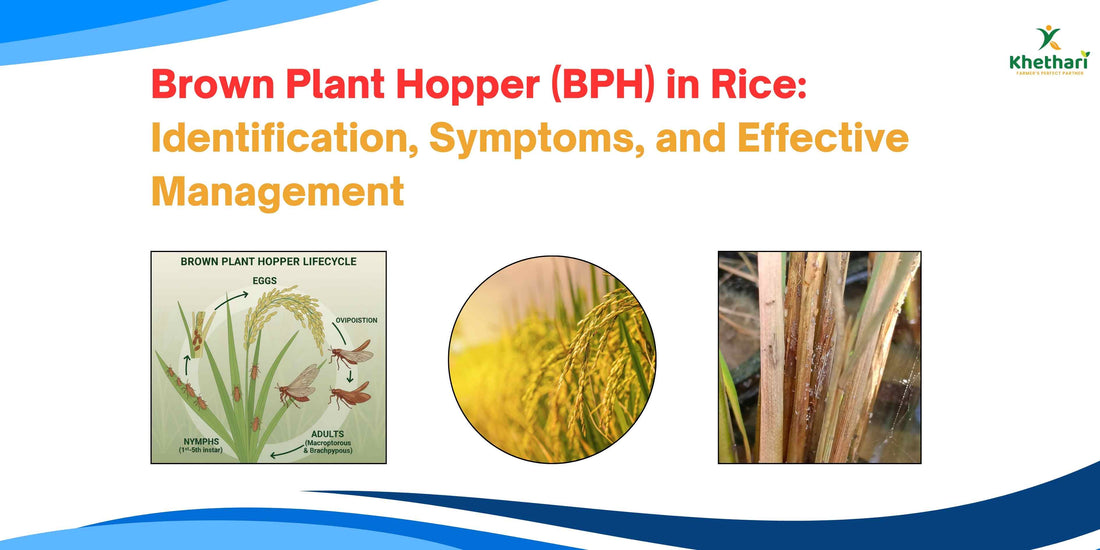
Brown Plant Hopper (BPH) in Rice: Identification, Symptoms, and Effective Management
1. Introduction
Rice is one of the most important staple crops across India and Asia, providing food and livelihood to millions of farmers. However, the productivity of rice is often threatened by several pests and diseases that reduce yield and grain quality.
Among these, the Brown Plant Hopper (BPH) (Nilaparvata lugens) is one of the most destructive sucking pests. It not only damages rice plants directly but also acts as a vector for viral diseases such as grassy stunt and ragged stunt virus. Understanding its biology, symptoms, and management is crucial for achieving sustainable and profitable rice production.
2. Scientific Classification and Identification
- Scientific Name: Nilaparvata lugens
- Order: Hemiptera
- Family: Delphacidae
Identification:
- Adults: Light to dark brown, with either short or long wings (brachypterous or macropterous forms).
- Nymphs: Pale white or light brown, soft-bodied, and very active.
- Distinguishing Feature: Presence of a brown band on the abdomen and a sucking proboscis used to feed on plant sap.
3. Life Cycle
The BPH completes its life cycle in about 25–30 days, depending on temperature and humidity.
Egg Stage:
- Eggs are inserted into the midrib of rice leaves or leaf sheaths.
- Hatching occurs in 6–9 days.
Nymph Stage:
- Nymphs undergo five instars over 12–15 days.
- They are highly active and feed continuously on plant sap.
Adult Stage:
- Adults live for about 10–20 days.
- Reproduction is rapid under warm, humid, and densely planted conditions — leading to population outbreaks.
Favorable conditions: High humidity, stagnant water, and excessive nitrogen application favor the multiplication of BPH.

4. Nature of Damage
The Brown Plant Hopper feeds on the sap from the base of rice plants, depriving them of essential nutrients and water. Continuous feeding leads to:
- Yellowing and wilting of leaves.
- “Hopper burn” — a condition where plants dry up in circular patches.
- Lodging and reduced grain filling.
- Severe yield losses, especially in late crop stages.
In heavy infestations, entire fields may appear scorched and dry even though sufficient water is present.
5. Symptoms of Infestation
- Clusters of insects visible at the base of the plant.
- Yellowing and drooping of leaves.
- Hopper burn patches appearing in the field.
- Stunted plant growth and drying up in severe cases.
- Presence of sooty mould on leaves due to honeydew excretion.
6. Favorable Conditions
- High relative humidity (70–80%) and temperatures around 25–30°C.
- Excessive use of nitrogen fertilizers.
- Dense plant population and stagnant water.
- Continuous cropping of rice without rotation.
7. Management and Control
Integrated Pest Management (IPM) is the most effective and eco-friendly strategy to control BPH in rice.
a) Cultural Practices
- Maintain optimum spacing (to improve aeration and light penetration).
- Avoid excess nitrogen application.
- Drain water temporarily to reduce pest buildup.
- Grow resistant varieties such as Pusa Basmati 1, IR 64, Swarna, and Rasi.
- Avoid continuous monocropping of rice.
b) Biological Control
- Encourage natural predators like spiders, mirid bugs, ladybird beetles, and dragonflies.
- Use fungal biocontrol agents such as Beauveria bassiana or Metarhizium anisopliae.
- Release egg parasitoids such as Anagrus flaveolus.
c) Chemical Control (if necessary)
When the pest population exceeds the Economic Threshold Level (ETL) (10–15 hoppers per hill), use selective insecticides such as:
- Imidacloprid 17.8 SL @ 0.5 ml/litre of water
- Buprofezin 25 SC @ 1 ml/litre of water
- Thiamethoxam 25 WG @ 0.25 g/litre of water
🟠 Apply chemicals judiciously, avoid repeated use of the same group, and protect natural enemies.
8. Preventive Measures
- Regularly monitor pest population, especially during the tillering and booting stages.
- Avoid indiscriminate use of broad-spectrum insecticides that kill beneficial insects.
- Maintain field sanitation and balanced fertilization.
- Follow an Integrated Pest Management (IPM) approach combining cultural, biological, and chemical methods.
9. Conclusion
The Brown Plant Hopper remains one of the most serious pests affecting rice productivity in India and across Asia. Its management requires early detection, balanced nutrition, and eco-friendly pest control strategies. By adopting Integrated Pest Management (IPM), farmers can protect their crops effectively while maintaining environmental safety and long-term sustainability.

